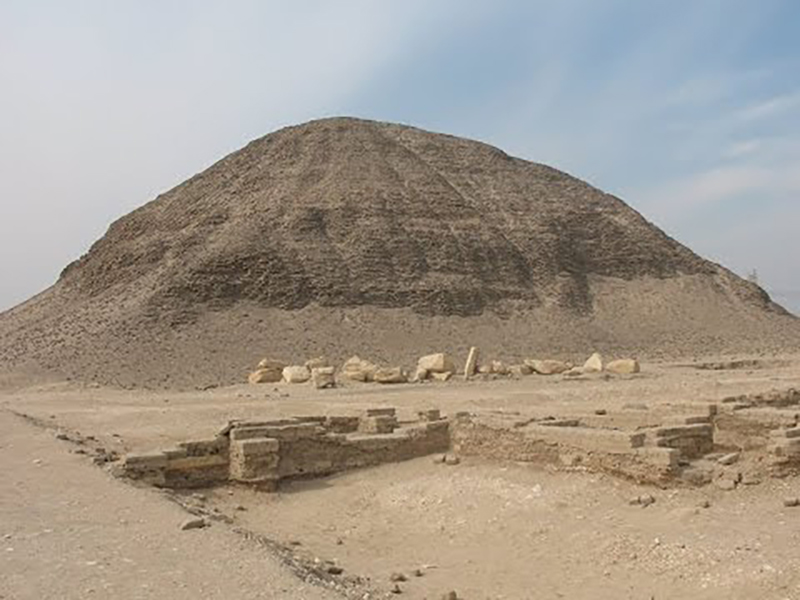
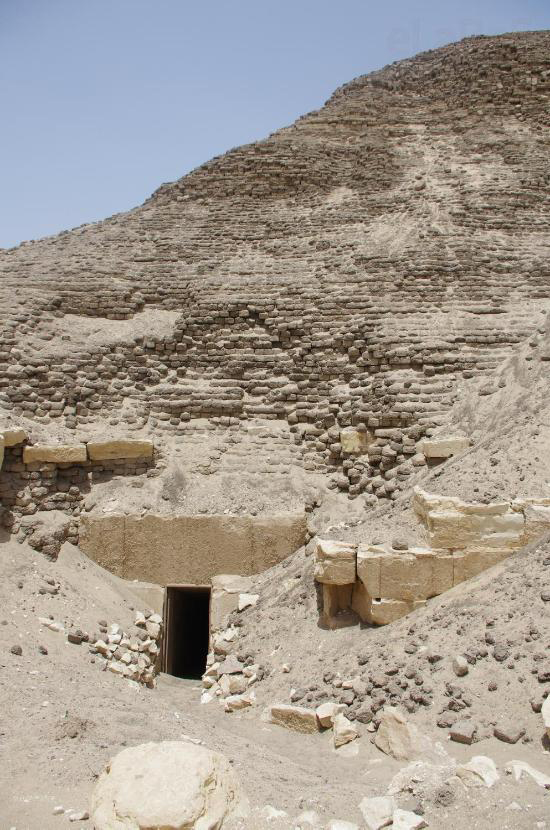


Original name: unknown
Original height: 58 m / 193 ft
Base length: 100 m / 333 ft.
Angle of inclination: 48° 45'
Date of construction: 12th dynasty
Hawara is an archaeological site of Ancient Egypt, south of the site of Crocodilopolis ('Arsino‘', also known as 'Medinet al-Faiyum') at the entrance to the depression of the Fayyum oasis. It is the site of a pyramid built by the Pharaoh Amenemhat III in the 19th century BC.
Amenemhat III was the last powerful ruler of the 12th Dynasty, and the pyramid he built at Hawara (illustration, right) is believed to post-date the so-called "Black Pyramid" built by the same ruler at Dahshur. This is believed to have been Amenemhet's final resting place. At Hawara there was also the intact (pyramid) tomb of Neferu-Ptah, daughter of Amenemhet III. This tomb was found about 2 km south of the king's pyramid.
In common with the Middle Kingdom pyramids constructed after Amenemhat II, it was built of mudbrick round a core of limestone passages and burial chambers, and faced with limestone. Most of the facing stone was later pillaged for use in other buildings - a fate common to almost all of Egypt's pyramids - and today the pyramid is little more than an eroded, vaguely pyramidal mountain of mud brick, and of the once magnificent mortuary temple precinct formerly enclosed by a wall there is little left beyond the foundation bed of compacted sand and chips and shards of limestone.
The huge mortuary temple that originally stood adjacent to this pyramid is believed to have formed the basis of the complex of buildings with galleries and courtyards called a "labyrinth" by Herodotus (see quote at Labyrinth), and mentioned by Strabo and Diodorus Siculus. (There is no historicity to the assertion of Diodorus Siculus that this was the model for the labyrinth of Crete that Greeks imagined housed the Minotaur.) The demolition of the "labyrinth" may date in part to the reign of Ptolemy II, under whom the Pharaonic city of Shedyt (Greek Crocodilopolis, the modern Medinet el-Fayum) was renamed to honour his sister-wife Arsino‘; a massive Ptolemaic building program at Arsinoe has been suggested as the ultimate destination of Middle Kingdom limestone columns and blocks removed from Hawara, and now lost.
Pharaoh Sobekneferu of the Twelfth Dynasty also built at the complex. Her name meant "most beautiful of Sobek", the sacred crocodile.
From the pyramid entrance a sloping passageway with steps runs down to a small room and a further short horizontal passage. In the roof of this horizontal passage there was a concealed sliding trapdoor weighing 20 tons. If this was found and opened a robber would find himself confronted by an empty passage at a right angle to the passage below, closed by wooden doors, or by a passage parallel to the passage below, carefully filled with mud and stone blocking. He would assume that the blocking concealed the entrance and waste time removing it (thereby increasing the likelihood of detection by the pyramid guardians).
In fact there was a second 20-ton trapdoor in the roof of the empty passage, giving onto a second empty passage, also at a right angle to the first. This too had a 20-ton trapdoor giving onto a passage at a right angle to its predecessor (thus the interior of the pyramid was circled by these passages). However this passage ended in a large area of mud and stone blocking that presumably concealed the burial chamber.
This, however, was a blind and merely filled a wide but shallow alcove. Two blind shafts in the floor, carefully filled with cut stone blocks, further wasted the robbers' time, for the real entrance to the burial chamber was even more carefully concealed and lay between the blind shafts and opposite the alcove.
Despite these elaborate protective measures, Petrie found that none of the trapdoors had been slid into place and the wooden doors were open. Whether this indicated negligence on the part of the burial party, an intention to return and place further burials in the pyramid (when found there were two sarcophagi in the quartzite monolith described below and room for at least two more), or a deliberate action to facilitate robbery of the tomb, we cannot know.
The burial chamber was made out of a single quartzite monolith which was lowered into a larger chamber lined with limestone. This monolithic slab weighed an estimated 110 tons according to Petrie. A course of brick was placed on the chamber to raise the ceiling then the chamber was covered with 3 quartzite slabs (estimated weight 45 tons each). Above the burial chamber were 2 relieving chambers. This was topped with 50 ton limestone slabs forming a pointed roof. Then an enormous arch of brick 3 feet thick was built over the pointed roof to support the core of the pyramid.
The entrance to the pyramid is today flooded to a depth of 6 metres as a result of the waters from the Bahr Yusuf (Joseph's) Canal, which flows around two sides of the site and passes within 30m of the pyramid.
The first excavations at the site were made by Karl Lepsius, in 1843. William Flinders Petrie excavated at Hawara, in 1888, finding papyri of the 1st and 2nd centuries CE, and, north of the pyramid, a vast necropolis where he found 146 portraits on coffins dating to the Roman period, famous as being among the very few surviving examples of painted portraits from classical antiquity, the "Fayum" mummy portraits from Roman Egypt. Among the discoveries made by Petrie were papyrus manuscripts, including a great papyrus scroll which contains parts of books 1 and 2 of the Iliad (the "Hawara Homer" of the Bodleian Library, Oxford).
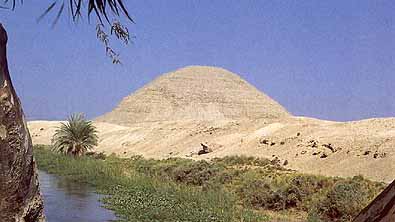
Amenemhet III built his second pyramid closer to the area that he seemed to love, the Fayoum. It was not the only building he did there. He also built a temple in Kiman Faris (Faras) to the Fayoum's chief divinity, the crocodile god Sobek. Kiman Faris was known to the Greeks as Krokodilopolis, or more commonly, Crocodilopolis. Nearby close to the modern village of Biahmu, he also constructed two colossal 12 meter high quartzite statues with enormous bases.
After the failure of his Dahshur Pyramid after almost 15 years worth of work, he more or less completely abandoned that pyramid and started completely over with a new pyramid located near the modern village of Hawara el-Makta, not far from Senusret II's pyramid at el-Lahun (Kahun). The pyramid lies on a long spit of low desert, and was built vary differently then his pyramid at Dahshur. The name of this pyramid has never been discovered for certain, but it might have been called "Amenemhet Lives".
The Lepsius expedition attempted to enter the pyramid in 1843, and about 1883, Luigi Vassalli tried again, but not until Petrie in 1889 was the interior actually investigated. Petrie was working with Wainwright and MacKay at the time and it took him two difficult seasons to finally reach the burial chamber.
There was apparently a valley temple connected with the pyramid by a a causeway that lead to the enclosure wall that surrounds the entire complex. The causeway appears to enter the enclosure wall near its southwest corner. However, neither the valley temple or the causeway, for the most part, have been investigated seriously.
Petrie not only investigated the pyramid fairly thoroughly, he apparently also closely examined the huge mortuary complex associated with the pyramid. The reason that modern and not so modern travelers call this the Labyrinth is because of the complex, but splendid mortuary temple located on the pyramid's south side.. Herodotus, Diodorus Siculus, Strabo and Pliny all make reference to this structure. According to Diodorus, Daedalus was so impressed by the temple that he built his own labyrinth for Minos in Crete based on Amenemhet III's temple.
Regrettably, the structure is mostly in ruins today, and the floor plan can no longer be precisely determined. It was quarried for material since Roman times, and all that is left is a foundation bed of sand and limestone chips. The inner part of the mortuary temple and particularly the offering hall was probably located in the back of the mortuary temple, as would be customary, near or up against the pyramid. In front of it was a whole system of columned halls, columned courtyards, porticos, colonnades, chambers and passageways. To the south there was another extensive open courtyard.
The whole complex covered some 28,000 square meters. Strabo tells us there were as many halls as there were provinces in Egypt, of which there were 42. He also tells us that each hall honored the divinities of the various provinces. Herodotus speaks of 12 main courtyards, and said that the visitor was conducted "from courtyards into rooms, rooms into galleries, galleries into more rooms, thence into more courtyards". Both Herodotus and Piny the Elder also mention lower rooms, or crypts devoted to the sacred crocodiles representing Sobek. All that Petrie was able to find were the statues of Sobek and Hathor, along with one unusual palm goddess. He also found a statue of Amenemhet III in a nearby irrigation canal that probably belonged to the temple.
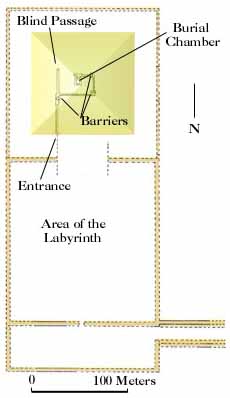
The pyramid itself was built in typical 12th Dynasty fashion with a mudbrick core and a casing of fine white limestone. The entrance to the subterranean levels was located in the actual face of the pyramid on the south side, very near the southeast corner. Within the pyramid, a descending corridor with a stairway first lead north. This corridor, which descends to a lower level then the burial chamber, was sheathed in fine white limestone, continued until reaching a small chamber, and continuing straight leads to a blind dead end. However, the builders used an elaborate device first seen in the Abydos tomb of Senusret III. A second corridor is hidden within the ceiling of the small chamber.
It was originally meant to be blocked by a 20 ton quartzite slab. This corridor very shortly arriving at a second chamber. From this chamber, two corridors depart, one north, and another to the east. The northern passage appears to dead end, but it was difficult to explore and could possibly lead to a "Southern Tomb" like that built within his Dahshur pyramid. This corridor was filled with mud that was probably the remains of mudbrick used to fill this corridor and seal it. The eastern passage, once closed by a wooden door, skirted the eastern side of the burial chamber before again arriving at a small chamber with another hidden ceiling corridor that was suppose to be blocked by a barrier portcullis. After this barrier another 90 degree turn back to the left (north) through a short corridor that leads to a final barrier with the same design. However, this barrier was actually in place. After a final 90 degree left turn back to the west one finally arriving at the northern side of first an antechamber and then the burial chamber. The burial chamber is just off of the vertical axis of the pyramid.
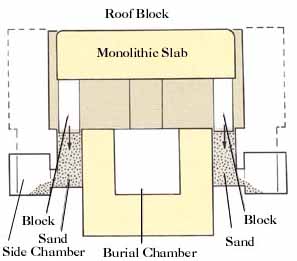
After the disastrous results with Amenemhet III's pyramid at Dahshur, the builders took more precautions this time. The substructure was much less complex then the pyramid at Dahshur, with fewer corridors and chamber. In order to make sure the burial chamber was stable, they dug a rectangular hole in the rock subsoil and lined it with limestone blocks, thus forming the side walls of the burial chamber. Of course, this also meant that the burial chamber was not as deep below the pyramid. Next, they lowered a huge, quartzite monolith that weighed some 110 tons into the chamber.
It completely filled the burial chamber, and they carved out a rectangular hole to receive the quartzite sarcophagus, which was decorated with niches. Inside it was a second sarcophagus. The builders also carved out niches in the monolith for two canopic chests. Three more quartzite slabs surmounted the Quartzite monolith. One was propped up on smaller blocks to leave a space to introduce the king's mummy and coffins. So that this slab could be lowered, the builders constructed the first known sand lowering device.
The blocks, or small pillars that the raised slab rested on in turn rested on sand filled shafts to either side of the vault. When the sand was removed through side galleries, the blocks descended along with the ceiling slab. In order to reduce the weight on the burial vault, these three huge slabs extended beyond the sides of the vault and rested on sides of the bedrock trench that dug for the burial chamber. We see the same sort of construction and sarcophagus in the probable later pyramids located at Mazghuna.
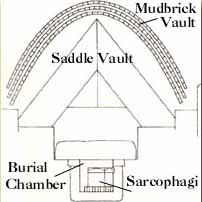
They also took precautions with the ceiling of the burial chamber. Over the flat ceiling composed of the limestone monolith slabs, they added a saddle vault, also of enormous limestone monoliths each weighing more then 50 tons, and over them another massive brick vault about seven meters high. They had finally constructed a burial chamber capable of supporting the enormous pressure of the pyramid's mass. But the entire pyramid was also constructed with a less radical slope then his pyramid at Dahshur, so there was actually less mass atop the burial chamber.
While they may have managed to secure the structural integrity of the subterranean chambers, they did not deter the tomb robbers who managed to make their way to the burial chamber and burn the rulers wooden coffin anyway.
Petrie managed to find, within the antechamber of the pyramid, duck shaped bowls, a second wooden coffin and an alabaster offering table inscribed with the name of Princess Neferuptah, one of Amenemhet III's daughters. Therefore, for some time it was thought that Princess Neferuptah had been interred with her father, but that was later shown to be inaccurate.
In 1956, Naguib Farag unearthed another completely destroyed pyramid about two kilometers southeast of Amenemhet III's pyramid. In it a pink granite sarcophagus was found that also bore the name of this princess, along with traces of two wooden coffins and fragments of mummy linen. Her name was also on other funerary equipment within this pyramid, leading archaeologists, to their great surprise, to presume that the princess was buried in this pyramid instead of Amenemhet III's. However, not everyone is convinced, due to the offering table found in Amenemhet III's pyramid.
The whole complex including the mortuary temple, the pyramid and a small North temple were surrounded by a rectangular, north-south oriented enclosure wall. This was the largest such enclosure wall wall of any middle kingdom pyramid.